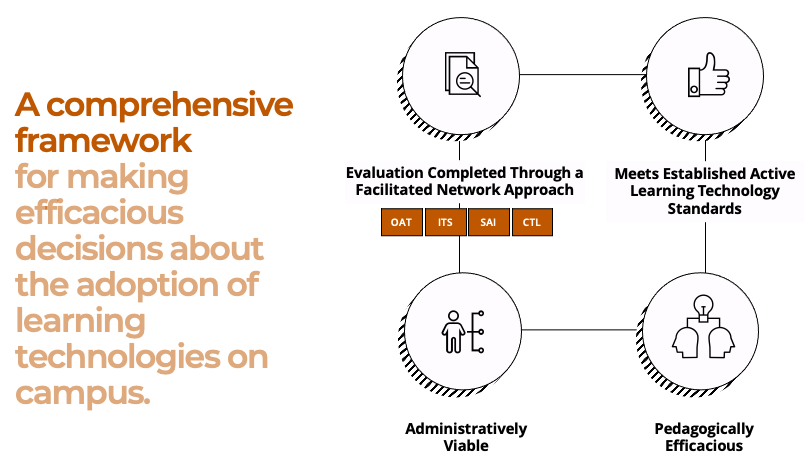Learning Technology Adoption Process (LTAP)
UT Austin’s LTAP offers a comprehensive framework for formally vetting academic technologies. This framework is designed to provide a systematic way for stakeholders to engage in data-driven decisions about adopting learning technologies on campus. An LTAP provides a central strategy for coordinating academic technology ecosystems with attention to UT Austin’s principles of effective teaching, pedagogical resources, training and support, managing security and privacy concerns, improving end-user experiences and advancing digital literacy within our community.
Our latest LTAP evaluates the generative AI tool within Grammarly for Education. More information about this LTAP can be found here. Additional resources on the LTAP can be find to the right.
Focus Areas
Adopting technology into higher education responsibly is a large task – the future careers of students, the voices of faculty and staff, and the reputation of the University all must be taken into account. UT Austin undergoes a robust Learning Technology Adoption Process (LTAP) when considering applying new technologies to our learning environment.
LTAPs drive future-forward adoption of academic technology via three focus areas:
- Pedagogical efficacy
- End-user experience (including usability, privacy, security and accessibility)
- Administrative viability (campus sustainability, including service, support, vendor affinity and cost)
Learning tools are all unique, LTAPs are agile and can be tailored to unique feature sets and value propositions for a specific technology or platform. LTAPs always involve drawing on primary and secondary research to make determinations. The most comprehensive LTAP, “Tier IV”, involves extensive user research and feedback from faculty, students, and staff. Tier IV LTAPs use a 56-criteria Scorecard. Less intensive tiers include a lite version that affords smaller, self-directed evaluations. The outcome of an LTAP is an evidence-based recommendation on a tool or set of tools.

Frequently Asked Questions
The LTAP framework allows the University community to make evidence-based decisions in academic technology related to criteria that are critical to the teaching and learning mission, such as pedagogy, privacy and accessibility, and sustainability for our campus.
It depends on the extent of the planned technology adoption or use case for the tool. Some LTAPs involve mini-studies, whereas others involve yearlong pilots with extensive user research; other LTAPS exist somewhere in between these two examples.
While many factors determine the order in which tools are evaluated, a primary factor is contract expiration of tools currently in use at UT. We also consider faculty interest, as well as gaps in our current selection of vetted and approved tools.
We encourage all members of the UT Austin community to engage with us to evaluate learning technologies for adoption on campus. You can submit a request to the OAT at oat@utexas.edu to get a consultation on the LTAP process.
It depends. Our roadmap accommodates at least one comprehensive LTAP per year. The OAT Roadmap provides the status of current evaluations.
Contact the OAT at oat@utexas.edu to express interest.